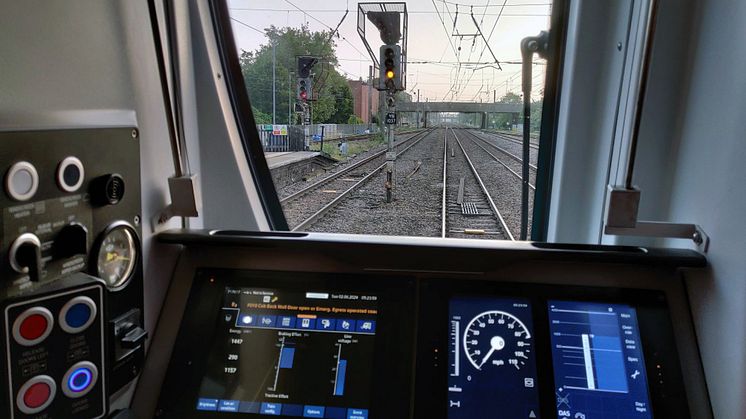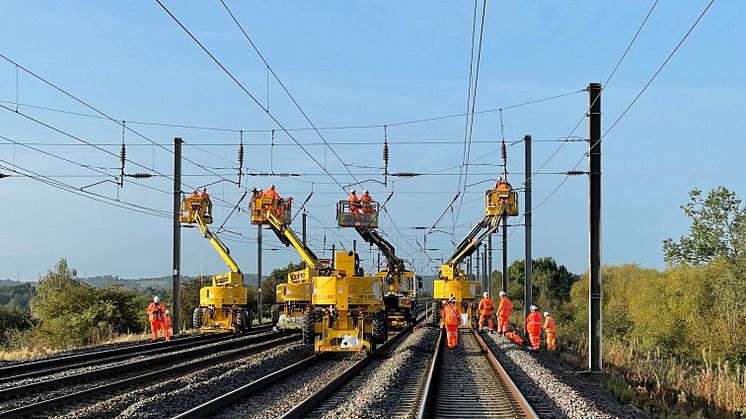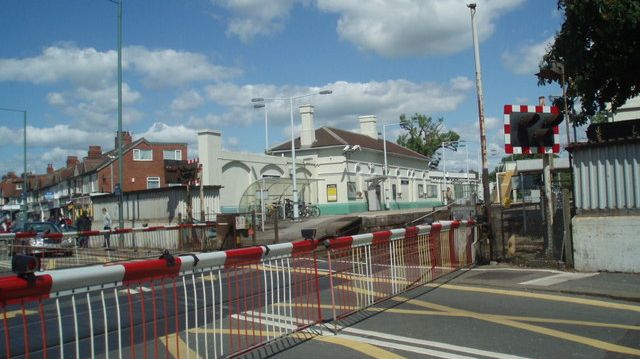
Press release -
Thameslink and Great Northern service changes for in-cab signal tests
Network Rail has issued the following press release:
- East Coast Main Line passengers are urged to check before they travel due to further digital signalling testing taking place at the end of November.
- Thameslink and Great Northern services between London and Peterborough/King’s Lynn will be affected, with rail replacement bus services in place.
- It’s part of continuing work on the £1.4bn East Coast Digital Programme (ECDP).
Rail passengers are being advised to plan their journeys in advance ahead of further work taking place to test 21st century digital signalling systems on the East Coast Main Line.
The £1.4 billion-pound East Coast Digital Programme will see traditional, lineside signals replaced with signalling displayed inside drivers’ cabs, which will mean more reliable journeys and a greener railway for passengers in the future.
On Saturday 30 November and Sunday 1 December, further testing will take place of the recently installed system between Welwyn Garden City and Hitchin. This is part of ongoing preparations for trains to run on this route using digital signalling from late 2025.
For the testing to be carried out under controlled conditions, the railway needs to be closed in and around the affected section.
There will be no Thameslink or Great Northern trains between Potters Bar and St Neots, Potters Bar and Royston, or between Hertford North and Stevenage on Saturday 30 November and Sunday 1 December.
Instead, rail replacement buses will keep passengers on the move (see notes to editor), with people reminded to check before they travel and leave extra time for their journeys.
Long distance services on the East Coast Main Line will also be affected by the work and details can be found here.
The advice from Network Rail and train operators is to check before you travel by using www.nationalrail.co.uk or by checking train operator websites.
Ricky Barsby, Network Rail’s Head of Access Integration, ECDP, said: “The testing work is a further step towards the introduction of digital, in-cab signalling on the East Coast Main Line, which will improve services for passengers and create a more reliable and greener railway.
“We recognise the work will lead to journeys taking longer over that weekend. We thank all those affected for their patience and understanding.”
The East Coast Digital Programme is being delivered in partnership with all train operators which operate on the East Coast Main Line to deliver the first-of-a-kind signalling project.
Jenny Saunders, Thameslink and Great Northern’s Customer Services Director, said: “I thank customers for their patience whilst Network Rail carries out this vital work, which will improve the reliability of services in the long run. There will be rail replacement buses to help keep customers on the move and I urge people to plan their journeys and allow plenty of extra time.”
The European Train Control System (ETCS) testing planned for Sunday 30 November and Sunday 1 December is expected to involve a Great Northern Class 717 commuter train and a Grand Central Class 180 passenger train.
Testing and proving will continue between Welwyn and Hitchin at various stages in the coming months, involving different trains and onboard systems.
Much of the work will be done overnight, avoiding any impact on regular passenger services.
For further information about the ECDP please visit www.eastcoastdigitalprogramme.co.uk
ENDS
Notes to Editors
More detail on rail replacement buses / train diversions:
On Saturday 30 November and Sunday 1 December
No trains will run between:
- Potters Bar and St Neots
- Potters Bar and Royston
- Hertford North and Stevenage
A rail replacement bus service will run between:
- Potters Bar and Hitchin
- Hitchin and Royston
- Hertford North and Stevenage
- St Albans City and Stevenage via Hatfield
- Luton Airport Parkway and Stevenage via Hitchin
- St Neots and Bedford
- St Neots and Hitchin
Trains will run between:
- St Neots and Peterborough
- Royston and Cambridge/Kings Lynn
- London King’s Cross and Potters Bar
- Moorgate and Potters Bar / Hertford North
Digital signalling
Digital signalling, using ETCS is a proven technology already in use in many countries in Europe and elsewhere. The ECDP will see the first introduction of ETCS to an intercity mainline in Great Britain, and will provide the foundation for the future expansion of digital signalling across the network. ETCS is currently in use in the central London section of Thameslink and on the Cambrian Line in Wales, and now on the Northern City Line (Finsbury Park to Moorgate), in the first stage of ECDP.
More reliability: With signalling information being provided directly to the driver, via a screen in their cab, there will no longer be a need to maintain a large amount of lineside equipment involved with traditional ‘traffic light’ signals. As a result, the amount of signalling-related engineering work will reduce in the future by around almost half. Additionally, trains are sometimes affected by signal failures; moving to a modern, digitally based system makes this less likely, potentially reducing thousands of hours of delays, and making train services more reliable.
More punctual services: Digital signalling gives train drivers continual information about the safe maximum speed for their train. It provides drivers with additional information about the route ahead, that today’s fixed ‘traffic light’ signals do not. This enables more ‘efficient’ operations, helping trains stay on time. The new technology allows continuous communication between the trackside and onboard equipment. Signallers can continuously communicate with every train on the network and respond in real time using digital tools to help smooth the flow of trains and recover services more quickly after disruption.
Greener journeys: Digital signalling contributes to a greener railway. The East Coast Main Line is already electrified, and these upgrades will deliver a further 55,000 tonne reduction in carbon emissions over 60 years – the equivalent to over 65,000 one-way flights from London to New York, or over 2 million passenger train journeys from London to Edinburgh. This is because there is much less physical equipment to produce and maintain compared with what’s needed for ‘traffic light’ signals. The estimated whole life carbon saving over a 60-year period (the expected life span of a ‘traditional’ signalling system) is around 39%. The technology also allows gentler braking, meaning journeys are smoother and use less energy. Finally, a more reliable and punctual railway will encourage more people to choose rail over road and air, ultimately reducing transport emissions for the long-term.
Topics
Categories
For more information, contact the press office on 0203 750 2031.
Govia Thameslink Railway
Govia Thameslink Railway (GTR) operates Thameslink, Great Northern, Southern and Gatwick Express services as follows:
- Thameslink – cross-London services between Bedford/Peterborough/Cambridge and Brighton/Horsham/East Grinstead, and between Luton/St Albans and Sutton/Wimbledon/Rainham; plus services between London and Sevenoaks
- Great Northern – services between London and Welwyn, Hertford, Peterborough, Cambridge and King’s Lynn
- Southern – services between London and the Sussex coast (Brighton, Worthing, Eastbourne, Bognor Regis, Hastings) and parts of Surrey, Kent and Hampshire (Ashford International, Southampton, Portsmouth)
- Gatwick Express – fast, non-stop direct services between Gatwick Airport and London Victoria
www.southernrailway.com, www.thameslinkrailway.com, www.gatwickexpress.com, www.greatnorthernrail.com


